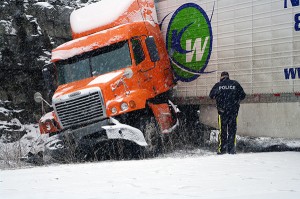Home »

Truck chain-up regulations feedback sought
 The Ministry of Transportation and Infrastructure (MOTI) is seeking feedback from the commercial vehicle industry on proposed enhanced chain-up regulations and related fines for B.C. highways.
The Ministry of Transportation and Infrastructure (MOTI) is seeking feedback from the commercial vehicle industry on proposed enhanced chain-up regulations and related fines for B.C. highways.
A majority of commercial vehicle operators use chains appropriately. However, a number of winter highway closures were necessary because some drivers either were not using chains or were installing them incorrectly, noted a MOTI media release.
“These new, proposed chain-up regulations and fines have been designed to improve compliance, which will mean safer highways with fewer closures in winter months.”
Proposed changes will include:
- An increase in the number of tires requiring chains on each commercial vehicle. The current requirement is one tire per vehicle.
- A specified industry standard for quality of chain. There is currently no set standard.
- Escalating fines for not carrying chains, bypassing an active chain-up, and causing a highway closure after bypassing an active chain-up. The current fine is $121 for not carrying chains, with no further escalating fines.
The ministry is encouraging all commercial truckers and related industry stakeholders to spend a few minutes taking the survey, which they can find here, in both English and Punjabi.
The survey is now open. Based on industry feedback, the ministry will recommend final regulations and fines in time for implementation next winter.
Ministry staff conducted a thorough review of 12 other jurisdictions, including three neighbouring Canadian provinces and nine comparable American states, before starting the engagement process.
In April, the ministry announced several enhancements to improve the safety and reliability of provincial roadways during winter weather conditions.
The following measures will go into effect Oct. 1:
* Stricter commercial vehicle chain-up requirements, including higher fines for commercial vehicles not carrying chains, or not chaining-up when required.
* A pilot program to restrict commercial vehicles from using the far-left lane on key three-lane highway sections in the winter, to ensure routes remain open to snowplows, emergency vehicles and passenger vehicles.
* Investing $1.8 million over the next three years in additional weather stations and overhead message signs, to provide better real-time weather and road condition information.
* Enhanced road-maintenance contractor monitoring and auditing, leveraging new tools and technology, like road weather stations, variable speed limit systems and GPS tracking of snowplows.
* Extending winter tire and chain regulations on select highways, including mountain passes and rural routes in high snowfall areas, from Oct. 1 to April 30 (instead of March 31), to account for late-season snowfall.
* More support for the Winter Driving Safety Alliance, through a specific winter-driving campaign, to promote safe winter-driving behaviour, and awareness for all drivers.
Members of the public can share their thoughts on all enhancements to winter preparation and maintenance by email: [email protected]
e-KNOW







